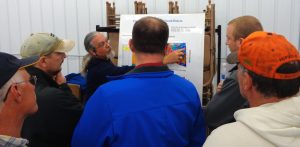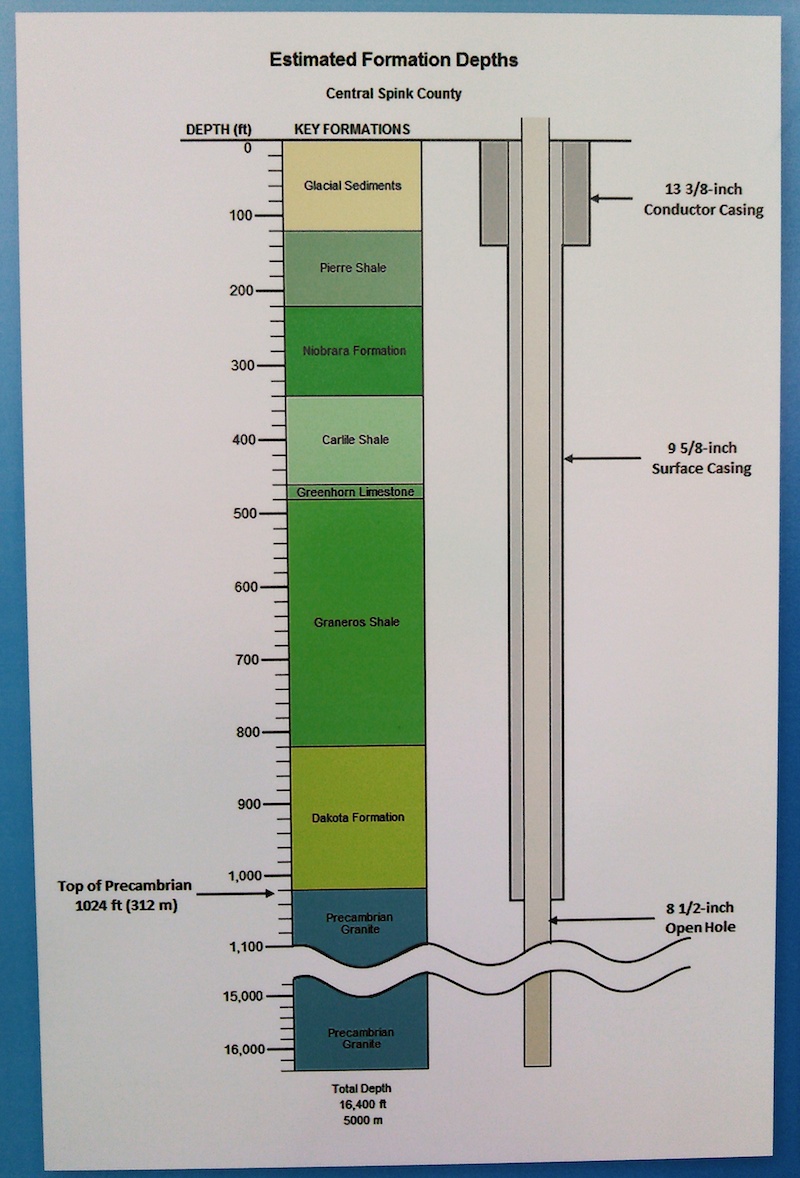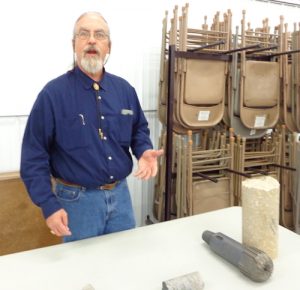Who’s excited about the Deep Borehole Field Test proposed for Spink County? Dr. Larry D. Stetler, professor of geological engineering at the South Dakota School of Mines and Technology.

Dr. Stetler was among the experts at the public meeting hosted by Battelle and the United States Department of Energy last night at the Spink County 4-H Building in Redfield to discuss the Deep Borehole Field Test, a science and engineering experiment that may take place in Spink County, if locals approve. The Energy Department wants to explore the feasibility of drilling 5,000-meter holes to dispose of some forms of nuclear waste in bedrock. Officials from Energy, Battelle, and Mines emphasized repeatedly throughout last night’s meeting and a similar session in Tulare Wednesday night that the Deep Borehole Field Test site in Spink County would not and cannot be used for nuclear waste.
DFP Friday Series on the Deep Borehole Field Test Meeting in Redfield:
- Mines Prof Stetler Explains Science of the Deep Borehole Field Test
- Battelle, US Energy Dept, Gov Daugaard Say No Nuclear Waste at Spink Deep Borehole Site
- Battelle’s Borehole Posters
- Lana Greenfield Seeks Political Cover from Deep Borehole Blowback, Slags Governor and Mines President Wilson
- Best Way to Protect Our Sacred Land from Borehole Nuclear Waste? Democracy.
Stetler thought he’d missed his chance to be involved with the Deep Borehole Field Test. His school had joined Parsons Brinckerhoff in a bid for the Borehole, but last January, Parsons Brinckerhoff lost out to Battelle, which proposed Rugby, North Dakota, for its drill site. But when local residents and county officials in Rugby declined to host the Borehole, Battelle went to the next good geological site on its list, and that’s the Benson Block of Milbank Granite under northeastern South Dakota. Battelle contacted the School of Mines in March and asked the school to serve as local experts for the initial public discussions about the Borehole. Stetler says Mines and Battelle have no contract in place yet, but if Spink County green-lights the project, he anticipates the school were serve the same scientific role as it would have partnering with Parsons Brinckerhoff.
Stetler said the most important science that he, his colleagues, and his students would do in the Borehole would be studying the rock brought up by the drill. He said the deepest recorded well hole in the area hit granite at 1,050 feet; the 16,400-foot/5,000-meter borehole would take us into uncharted geology in northeastern South Dakota.

The Borehole will produce a huge new geological dataset that Stetler says could produce new insights on the geological stability of the entire continent. Stetler expects the granite under Spink County is solid—after all, there is no tectonic activity, no seismic activity, no volcanic activity that could disrupt the bedrock. But if we find fractures, Stetler gets to ask all sorts of big geological questions, like what caused those fractures, are there any fluids in the fractures, how old are the fracturing and the fluids, and where do those fluids go?
Fractured bedrock would complicate the engineering of the project. Using boreholes to dispose of nuclear waste depends on drilling a hole as straight as possible so that waste canisters would slide all the way to the bottom. Engineers have dug deeper holes—over 31,000 feet in Oklahoma, past 40,000 feet in Russia—but never this straight. Stetler says we don’t even know if we can do it. A straight hole will be tricky enough in solid bedrock; fractured rock makes the bit veer and shake and gives less integrity to the Borehole wall.
Fractures would also raise the possibility of water infiltrating the disposal zone. Stetler hopes his department would also be involved in the hydrology testing planned once the hole is dug. He and his colleagues would test the age and composition of any fluids found in fractured rock to determine if those fluids are isolated deposits or if they match fluids found at higher levels. Any such mingling would mean a borehole would be an absolute no-go for waste disposal—remember, the whole point of this experiment is to determine whether we can dig a straight hole far enough down to isolate nuclear waste in bedrock, where even after its canister degrades, it will never come in contact with anything we might drink or touch or use.

For Stetler, the ideal science project would be to take core samples all the way down to 5,000 meters. Solid cylinders of rock would give him and his fellow geologists the most complete information about the composition of the bedrock. Conducting complete coring all the way down to 5,000 meters would take much more time and money than the six to eight months and $35 million Battelle’s Borehole project will take. Coring requires sending down the coring bit, grinding out a cylinder, breaking the core loose (think about that challenge: you can’t send a guy down that skinny hole to reach under the cut core and whack it free sideways with a chisel), hauling it to the surface, then sending the bit back down to drill some more. Stetler says the Borehole drill will likely send down the non-core bit to grind the bedrock into granite chips for most of the distance, with breaks at short intervals to take core samples to check for fractures.
We’ll discuss the political implications of this project in coming posts. But regardless of the politics, the Deep Borehole Field Test offers Stetler and his School of Mines colleagues a great opportunity to do the most basic and exciting science: to go where we haven’t gone and find out what’s there.
The geologists are just excited about the opportunity to study deep strata and could give a damn about nuclear waste storage…
Let’s start with some faint praise. Dr. Stetler is the first scientist who has come clean and laid out the year long (or longer) effort to land this project in South Dakota. Let’s pat him on the back. Finally, after a year of silence, when Dr. Stetler, Governor Daugaard and others have been plotting this effort in secret, we get the first admissions that, yes, South Dakota citizens were kept in the dark about this Department of Energy project. Secrecy and dishonesty is not the way science should be done, but it’s nice that maybe now the lies and deception will end and local and state citizens will get a probably too-late chance to weigh in.
Since SDSM&T isn’t under contract, it’s hard to know how much of Dr. Stetler’s talk can be held to hold to Battelle’s plans. And since Battelle’s legal right to move the sight from North to South Dakota with potentially different partners is at least legally questionable, it is difficult to know exactly what they claim about a project that was submitted by a completely different team can be trusted. DOE has created a horrible mess for itself by not figuring out “consent” before it rushed this project through a secretive process.
The drilling information has been covered in documents I’ve read, so there is really not much new there. There are those who think a gently curving borehole would be better for both science and canister emplacement.
If they were serious about the “science” part of this project they would core the whole borehole. But, this is a quick and dirty project meant to provide support pet project of Moniz.
Being that this project is almost in Harvey Wollman’s back yard, I would welcome Harvey’s comment.
quick and dirty reminds of our own Rep. heather Wilson, (R., N.M.), resuscitated from the dead pool of alleged or proven or admitted contract fraud, by SD Regents and hired as president, no less of SDSM&T (which has brought us numerous past collaborative superfund sites and other scientific cover-ups in the northern hills heap leach gold mine rush of the 80s, uranium mining, national waste dump sites, and dinosaurs), ostensibly to get us where we are today, likely by rounds and daugaard, to drill the holes in spink for DOE, opening the economic development mantra door (no. 3!!!) of SDGOP to sell anything we have so somebody else can take advantage of our lack of uranium, mining and environmental protection regs, financial regs, banking regs, and our SDGOP politicians’ willingness to listen to lobbyists and change the speed limits despite the death toll so they can drive back and forth to RC a half hour faster, or whatever else is needed to keep everybody else out (minorities) and net the quickest return, legal or not, for those close but not yet dead, to the decision makers in pierre and all theirs hangers-on-ers.
heather meanwhile does feel-good PR and human interest pieces in the school paper driving around town (when she is ever in town, am guessing in all her new sports cars or hum-vees or whatever else larry kurtz would know). where is larry when we need him?
every body is eager for her personal engagement with SD citizens on this project. tell us like it is heather. was it your idea to keep this consent business so quiet? we pay your and the rest of SDGOP’s checks, for the most part. is she our next joop? :)
Dr. Stetler states:
After all, there is no tectonic activity, no seismic activity, no volcanic activity that could disrupt the bedrock. But if we find fractures, Stetler gets to ask all sorts of big geological questions, like what caused those fractures, are there any fluids in the fractures, how old are the fracturing and the fluids, and where do those fluids go?
Is the Yellowstone super volcano getting ready to blow its cork?
ZONE ONE – INSTANT DEATH
ZONE 2 – 400,000 PEOPLE – 6 FEET OF ASH – INSTANT DEATH
ZONE 3 – 4 MILLION PEOPLE – 3 FEET OF ASH – ALMOST INSTANT DEATH
ZONE 4 – 1 TO 2 FEET OF ASH – MAYBE A MONTH OF LIFE – ONLY MAYBE
Clever Gov. Daugaard will have himself the greatest outhouse in the nation after these eggheads collect their data sets and move on. Bravo, SDSMT! Will it be a one seater or a two seater?
if the Yellowstone volcano blows, no one is going to give a hoot about nuclear waste.
I think SDSM&T profs and scientists are generally highly competent. Our group had good relationships with a number of profs there. Some we battled with, however. The profs we worked with sometimes had tips we could use, and they always gave us their honest opinions, which sometimes didn’t jibe with the official line coming from Pierre, but sometimes did. Like everyone else, they can have tunnel vision, especially where money for research projects come into play.
The science intrigues me but I’m not sure of the DOE’s intent.
Well, just heard about the building started 10 years ago to house the nuclear weapons and material in South Carolina. The building has cost $5 Billion and is 70% completed. Obama made the decision recently to scrap the project and will dispose of nuclear stuff in Mexico. Now I don’t know about any of you but I really do not believe Mexico is going to house this stuff and really can no longer believe anything Obama says or does. Now I find out we are drilling holes in South Dakota to see if the ground is sound enough to house nuclear material ………… Oh but they would never put this —- there. Who, in their right mind would depend on Mexico to defend the waste? I am pretty sure the Mexico angle is a cover. Sorry…….. can not trust anything this government says or does.